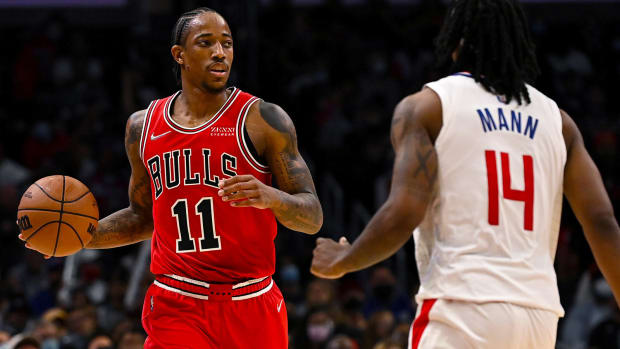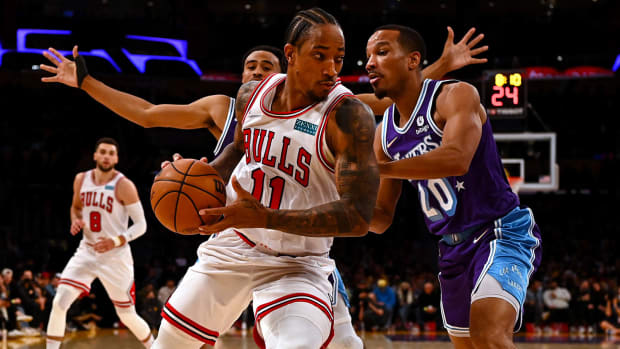The four-time All-Star has led Chicago to a hot start and near the top of the Eastern Conference.
It was quite the star turn for Bulls’ wing stud DeMar DeRozan to start the week.
Aside from making headlines with his play—scoring 35 and 38 points, respectively, in double-digit road victories over the Clippers and Lakers—DeRozan also made waves in a Yahoo Sports interview, saying he thought he was headed to Los Angeles to play for the purple-and-gold until the Russell Westbrook trade took place.
The news likely struck a chord with a subset of frustrated Lakers fans, given the darkhorse MVP numbers DeRozan was putting up for the resurgent, new-look Bulls. Then Wednesday night in Portland happened.
Like the rest of his club, DeRozan wilted in the second half, shooting 0-for-7—including 0-for-5 in the fourth and a brutal airball on a potential go-ahead shot in the closing seconds—as Chicago surrendered a 20-point lead to lose, 112–107.
But Wednesday’s outcome shouldn’t be much cause for concern—not for the Bulls, who’ve gotten out to a better start than just about anyone imagined, and certainly not for DeRozan, who’s lit baskets on fire all year.

John W. McDonough/Sports Illustrated
Here’s how hot DeRozan has been in the late stages so far this season: Even after missing all five of his shot attempts in that final quarter in Portland, he still leads the NBA in fourth-quarter field goal percentage among the 42 players who’ve taken at least 50 shots in fourth quarters thus far. His 110 points in fourth periods also rank best in the league to this point and are 15 more than the Magic’s Cole Anthony, who has the second-most.
After three years in San Antonio, which gets next to no national media exposure when the Spurs aren’t in title contention, DeRozan is getting newfound praise for aspects of his game he improved quite some time ago.
Even if you point to his improved, 35% three-point shooting—which has him above league average almost a fifth of the way through the year—sure. But all it’s done is offset his relative struggles from midrange, where so far he’s hit just under 36% of his long twos, down from better than 40% each of the past four seasons. Some may suggest that he’s changed up his game and been more aggressive, as he’s leading the league in free throws. But during his last year in San Antonio, he got to the line at a higher rate than he ever had before. And if it feels like he’s torching defenders when he gets them on an island more than usual, well … that’s been the case for a while, too. He actually led the NBA in points per isolation possession last season, even finishing ahead of Kevin Durant with a rate of 1.2 points per play, according to data from Second Spectrum. And yes, his scoring is up, but that makes perfect sense: With the Spurs, he asked to be more of a facilitator—and dished out nearly seven assists per night last year—so he couldn’t shoot as much as he gets to now.
In other words: DeMar’s been doing this for a while, whether you actually saw him in San Antonio or not.
“I think a lot of people counted him out, saying he was on the back end of his career. But this is probably one of his best years that he’s had in the NBA,” said teammate Lonzo Ball, also a Bulls newcomer. “I’ve always known what type of player he was. I don’t know how he got kind of got lost in the shuffle in San Antonio. But he’s one of the best players in the game, and I think he’s going out there and proving it every night.”
Much was made of DeRozan’s addition to the Bulls and how he would make life easier for 26-year-old All-Star Zach LaVine, who had too much offensive responsibility on his shoulders at times the past four years. Overlooked, though, was the fact that DeRozan has never played with an explosive wing scorer like LaVine, either. (And while he had LaMarcus Aldridge with the Spurs, DeRozan should benefit from Nikola Vučević’s range to the three-point line once he returns from his COVID-19-related absence.)
The result, with defenses less able to send a second defender, has been DeRozan getting whatever single-coverage looks he wants. As such, DeRozan is shooting exactly 50% on the season while averaging 26.6 points. If the numbers hold, DeRozan—in Year 13—would be the first player in NBA history to shoot 50% or better and average 25 points for the first time after his 10th season, according to Stats Perform.
Latest Into Career Averaging 25.0+ PPG with .500+ FG% For First Time – All-Time
Even as DeRozan and his teammates have the Bulls hovering near first place in the Eastern Conference—and as Chicago surprisingly boasts one of the league’s best defenses—no one should feel forced to pretend that DeRozan is influencing that trend.
He hasn’t always been as brutal as his reputation this season, and plays with active hands, and forcing occasional turnovers. He deflected a quick, sneaky Stephen Curry pass into the air a week ago, which started a Chicago fast break. (The Bulls have been lethal in transition.) And while he takes poor angles and gets hung up badly on screens at times, DeRozan hustles enough to get back into some plays where it looks like he’s out of the picture—like this one, where he intercepts a lob pass deep in the paint that was meant for Trey Lyles.

John W. McDonough/Sports Illustrated
Depending on where you look, some metrics will go as far as to tell you he’s been really good on D. Synergy Sports, for example, rates him as the NBA’s most efficient player at defending pick-and-roll ballhandlers (minimum of 30 plays defended). But more realistically, the collective lineup—and coach Billy Donovan—deserve credit for playing within a smart scheme that helps cover for DeRozan and Vučević’s shortcomings on that end. The Bulls are double-teaming in the post more than any other club in The Association, according to Synergy, often using their two best defensive players, Ball and Alex Caruso, to swarm and clamp down in the post when bigs try to take advantage of what they perceive to be mismatches.
The shift has been night and day, with Chicago being one of the worst teams at forcing turnovers last year to now being one of the best at it. The Bulls’ four-man group of Ball, Caruso, LaVine and DeRozan, specifically, rates in the league’s 82nd percentile at forcing turnovers, according to Cleaning the Glass. And even when teams don’t cough it up, the Bulls find ways to make it tough to score. Opponents take, on average, 12.1 seconds per possession to get shots off against Chicago, the third-longest in the league, per Inpredictable.
That combination—being able to cover DeRozan’s shortcomings while accentuating his strengths by playing him next to a scorer and set of passers of his caliber—has helped put the Bulls back on the map. And on some level, maybe it’s opened the eyes of those who failed to see all the ways DeRozan could still be a dominant player. Perhaps all he needed was the bigger market and the bolstered talent around him for some to notice.
More NBA Coverage:
• The Warriors Are Relishing the Skepticism
• NBA Power Rankings: Warriors and Nets Battle for No. 1
• Early NBA Season Awards Picks
• Kevin Durant and Stephen Curry Lead NBA MVP Race